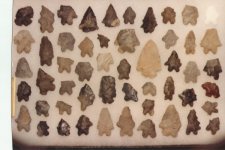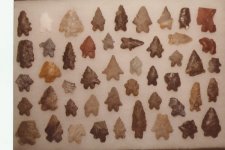Navigation
Install the app
How to install the app on iOS
Follow along with the video below to see how to install our site as a web app on your home screen.
Note: This feature may not be available in some browsers.
More options
You are using an out of date browser. It may not display this or other websites correctly.
You should upgrade or use an alternative browser.
You should upgrade or use an alternative browser.
BIFURCATES
- Thread starter wells
- Start date
redbeardrelics
Hero Member
- Jan 3, 2014
- 891
- 1,024
- Detector(s) used
- Garrett GTI 2500, (Ace 250 spare)
- Primary Interest:
- Other
Awesome collection of bifurcates Wells ! All the different styles and materials are represented there. Have you or anyone else ever heard a good or plausible reason for the bifurcations? I assume that perhaps these points were hafted onto a wood/bone shaft or handle that had a small protruding point or tit on it, and that the bifurcation fit over it, maybe allowing the hafting to be stronger in resisting side forces ? Has anybody read any wear and use analyses about bifurcates being confirmed to have been knives, or projectile points, or something else? It seems to me that most bifurcates ended up with tip breakage, and were then discarded or reworked again down to almost nothing left, you have several nice examples of heavily re-sharpened bifurcates represented here. It is also interesting to me that the bifurcates and the point styles that came just before them seem to be the most prevalent for heavy serrations, I wonder if this had anything to do with processing of plant materials that some say became an emphasis during the bifurcate time period. Thanks for showing
wells
Hero Member
- Thread starter
- #4
I ask those same questions and dont have any answers. I .look at them and say "why". They really are unique and very cool. I find a lot of their sites on hill tops, as a matter of fact just about every hill field in our valley produces them.Awesome collection of bifurcates Wells ! All the different styles and materials are represented there. Have you or anyone else ever heard a good or plausible reason for the bifurcations? I assume that perhaps these points were hafted onto a wood/bone shaft or handle that had a small protruding point or tit on it, and that the bifurcation fit over it, maybe allowing the hafting to be stronger in resisting side forces ? Has anybody read any wear and use analyses about bifurcates being confirmed to have been knives, or projectile points, or something else? It seems to me that most bifurcates ended up with tip breakage, and were then discarded or reworked again down to almost nothing left, you have several nice examples of heavily re-sharpened bifurcates represented here. It is also interesting to me that the bifurcates and the point styles that came just before them seem to be the most prevalent for heavy serrations, I wonder if this had anything to do with processing of plant materials that some say became an emphasis during the bifurcate time period. Thanks for showing
fishstick
Silver Member
- Oct 28, 2012
- 2,859
- 8,983
- Detector(s) used
- Fisher F5, T2SE, F2 for the boys, XP Deus
- Primary Interest:
- All Treasure Hunting
Broke or not those are SUPER lookin frames bud!!!! I like the flakin on BIFUR's, so simple yet so different.. NO expert but just how they are reworked suggests knifes.. HH..
Flea-bit Monkey
Sr. Member
- Apr 25, 2013
- 275
- 364
- Primary Interest:
- Relic Hunting
"So I think I will go out and pick up a pocket full Bifurcates today." I wish.
Those are so cool. Seeing so many together is awesome. Thanks for sharing.
Those are so cool. Seeing so many together is awesome. Thanks for sharing.
monsterrack
Silver Member
- Apr 15, 2013
- 4,419
- 5,819
- Detector(s) used
- Garrett, and Whites
- Primary Interest:
- All Treasure Hunting
JMO I will say 2 reason's 1st it was a certain type like a calling card for that time period or clan. 2nd the groove in the bottom when hafted, hafting glue or what ever they used would harden inside the groove making a much stronger bond.
Top Member Reactions
-
 3464
3464 -
 1966
1966 -
 1909
1909 -
 1155
1155 -
 1091
1091 -
 1008
1008 -
 881
881 -
 862
862 -
 861
861 -
 789
789 -
 754
754 -
 676
676 -
 659
659 -
 567
567 -
 507
507 -
 451
451 -
 447
447 -
 410
410 -
 401
401 -
E
398
Users who are viewing this thread
Total: 2 (members: 0, guests: 2)





